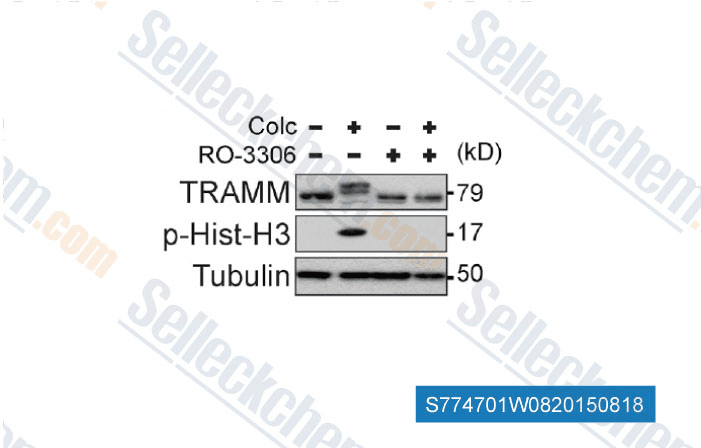|
Toll Free: (877) 796-6397 -- USA and Canada only -- |
Fax: +1-832-582-8590 Orders: +1-832-582-8158 |
Tech Support: +1-832-582-8158 Ext:3 Please provide your Order Number in the email. |
Technical Data
| Formula | C18H13N3OS2 |
||||||
| Molecular Weight | 351.45 | CAS No. | 872573-93-8 | ||||
| Solubility (25°C)* | In vitro | DMSO | 35 mg/mL (99.58 mM) | ||||
| Water | Insoluble | ||||||
| Ethanol | Insoluble | ||||||
| In vivo (Add solvents to the product individually and in order) |
|
||||||
|
* <1 mg/ml means slightly soluble or insoluble. * Please note that Selleck tests the solubility of all compounds in-house, and the actual solubility may differ slightly from published values. This is normal and is due to slight batch-to-batch variations. * Room temperature shipping (Stability testing shows this product can be shipped without any cooling measures.) |
|||||||
Preparing Stock Solutions
Biological Activity
| Description | RO-3306 is an ATP-competitive, and selective CDK1 inhibitor with Ki of 20 nM, >15-fold selectivity against a diverse panel of human kinases. RO-3306 enhances p53-mediated Bax activation and mitochondrial apoptosis. | ||||||||
|---|---|---|---|---|---|---|---|---|---|
| Targets |
|
||||||||
| In vitro | RO-3306 inhibits CDK1/cyclin B1, CDK1/cyclin A, CDK2/cyclin E, and CDK4/cyclin D activity with Ki of 35 nM, 110 nM, 340 nM, and over 2000 nM, respectively. Treatment of HCT116, SW480, and HeLa cells with RO-3306 for 20 h leads to a complete block of the cell cycle in the G2/M phase. The proliferation of both HCT116 and SW480 is effectively blocked by RO-3306. RO-3306 appears to be more proapoptotic in cancer cells (HCT116 and SW480) than nontumorigenic cells (MCF 10A and MCF 12A).[1] RO-3306 effectively arrests oocyte maturation at a concentration of 10 μM.[2] |
||||||||
| In vivo | RO-3306 is an ATP-competitive, and selective CDK1 inhibitor. |
Protocol (from reference)
| Kinase Assay: |
|
|---|---|
| Cell Assay: |
|
| Animal Study: |
|
References
Customer Product Validation

-
Data from [Data independently produced by , , J Cell Biol, 2015, 209(2): 221-34 ]

-
Data from [Data independently produced by , , Arthritis Rheumatol, 2016, 68(5):1222-32.]

-
Data from [Data independently produced by , , Sci Rep, 2017, 7:41950]

-
Data from [Data independently produced by , , Int J Mol Sci, 2018, 19(12)]
Selleck's Ro-3306 has been cited by 167 publications
| Synergistic induction of mitotic pyroptosis and tumor remission by inhibiting proteasome and WEE family kinases [ Signal Transduct Target Ther, 2024, 9(1):181.] | PubMed: 38992067 |
| Uncoupling of mTORC1 from E2F activity maintains DNA damage and senescence [ Nat Commun, 2024, 15(1):9181] | PubMed: 39448567 |
| Comprehensive multi-omics analysis reveals WEE1 as a synergistic lethal target with hyperthermia through CDK1 super-activation [ Nat Commun, 2024, 15(1):2089] | PubMed: 38453961 |
| Type II topoisomerases shape multi-scale 3D chromatin folding in regions of positive supercoils [ Mol Cell, 2024, S1097-2765(24)00830-X] | PubMed: 39486417 |
| Elucidation of the molecular mechanism of the breakage-fusion-bridge (BFB) cycle using a CRISPR-dCas9 cellular model [ Nucleic Acids Res, 2024, gkae747] | PubMed: 39193906 |
| Human AAA+ ATPase FIGNL1 suppresses RAD51-mediated ultra-fine bridge formation [ Nucleic Acids Res, 2024, gkae263] | PubMed: 38597669 |
| ATR limits Rad18-mediated PCNA monoubiquitination to preserve replication fork and telomerase-independent telomere stability [ EMBO J, 2024, 43(7):1301-1324] | PubMed: 38467834 |
| DIS3 depletion in multiple myeloma causes extensive perturbation in cell cycle progression and centrosome amplification [ Haematologica, 2024, 109(1):231-244] | PubMed: 37439377 |
| Proteomic analysis reveals a PLK1-dependent G2/M degradation program and a role for AKAP2 in coordinating the mitotic cytoskeleton [ Cell Rep, 2024, 43(8):114510] | PubMed: 39018246 |
| G2 arrest primes hematopoietic stem cells for megakaryopoiesis [ Cell Rep, 2024, 43(7):114388] | PubMed: 38935497 |
RETURN POLICY
Selleck Chemical’s Unconditional Return Policy ensures a smooth online shopping experience for our customers. If you are in any way unsatisfied with your purchase, you may return any item(s) within 7 days of receiving it. In the event of product quality issues, either protocol related or product related problems, you may return any item(s) within 365 days from the original purchase date. Please follow the instructions below when returning products.
SHIPPING AND STORAGE
Selleck products are transported at room temperature. If you receive the product at room temperature, please rest assured, the Selleck Quality Inspection Department has conducted experiments to verify that the normal temperature placement of one month will not affect the biological activity of powder products. After collecting, please store the product according to the requirements described in the datasheet. Most Selleck products are stable under the recommended conditions.
NOT FOR HUMAN, VETERINARY DIAGNOSTIC OR THERAPEUTIC USE.
